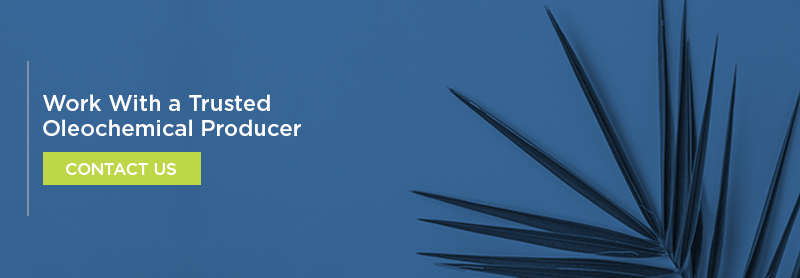Uses of Hydroxystearic Acid in the Cosmetics Industry
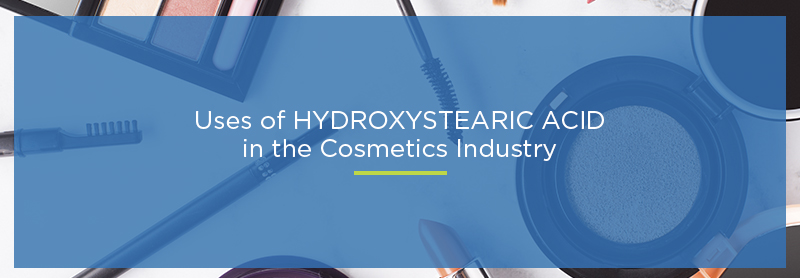
As the green cosmetics industry continues to grow, so does the need for sustainable cosmetics ingredients.
To produce green products, manufacturers must use natural, non-harmful ingredients. However, this is often easier said than done — finding useful and sustainable compounds can take time and trial-and-error.
Hydroxystearic acid could be the perfect solution. This versatile oleochemical is used across the cosmetics and manufacturing industries, from underarm deodorants and facial creams to rubber accelerators. Effective and beneficial, hydroxystearic acid is an attractive alternative to traditional surfactants, emollients and thickeners, and it is growing in popularity across the cosmetics industry.
Overview of Hydroxystearic Acid
Also called 12-hydroxy stearic acid and 12-HSA, hydroxystearic acid is a fatty acid surfactant, emollient and thickener. Hydroxystearic acid is used widely in a variety of personal care and cosmetics products, including skin care preparations, hair products and deodorizing products.
Structurally similar to stearic acid, hydroxystearic acid is entirely vegetable-based and derived from naturally-occurring fats and oils, most commonly castor oil. 12-HSA is synthesized by oxidizing 2-hexylcyclododecanone with a mixture of permaleic and peracetic acids in methylene chloride. This forms the lactone of hydroxystearic acid, and alkaline hydrolysis of the lactone produces 12-HSA.
Sold in solid flakes, hydroxystearic acid has a typical shelf life of up to two years past date of manufacture — the exact shelf life will vary based on storage conditions. To get the longest life out of hydroxystearic acid, store the chemical according to material safety data sheet (MSDS) recommendations.
Hydroxystearic Acid: An Oleochemical Solution
While many traditional chemicals are classified as petrochemicals, hydroxystearic acid is categorized as an oleochemical.
Petrochemicals are produced from petroleum oil-based products, and they are not known for their environmentally-friendly effects — many critics condemn petrochemicals for damaging the air, soil and water. Petrochemicals also tend to absorb easily into the skin, potentially creating issues in human health.
Alternately, oleochemicals are chemicals derived from natural sources, most commonly plant and animal fats. Because they are typically pollution-free, biodegradable and have very low toxicity, oleochemicals are an attractive alternative to traditional petrochemical compounds. Consumers are increasingly concerned about the ingredients of their cosmetic products — if something comes into contact with their skin, they want it to be natural and healthy.
Nonflammable, non-reactive and not an explosive hazard, hydroxystearic acid isn’t irritating to skin and doesn’t lead to respiratory distress. This makes hydroxystearic acid an especially attractive alternative to petroleum-based thickeners, emollients and surfactants on the market.
Hydroxystearic Acid in the Personal Care and Cosmetics Industry
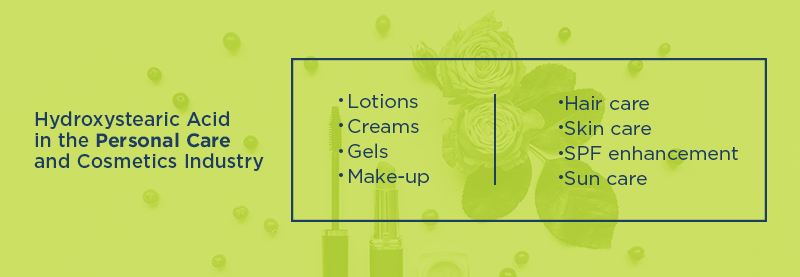
The most popular use for hydroxystearic acid is in the cosmetics and personal care industry. Because 12-HSA is effective in a range of functions, it is a versatile and popular ingredient for many different products.
Some of the most popular applications for hydroxystearic acid include the following products:
- Lotions
- Creams
- Gels
- Make-up and decorative cosmetics
- Hair care, such as shampoos, conditioners and styling products
- Skin care, such as facial care and cleansing, body care and baby care products
- SPF enhancement
- Sun care, such as sun protection, self-tanning and after-tanning products
- Underarm deodorants
In any given cosmetics product, hydroxystearic acid is used in three primary functions — as a surfactant, emollient and thickener.
1. Hydroxystearic Acid as a Surfactant
By itself, water is not the most effective cleaning agent.
While water loosens dirt and debris, it is repelled by grease and oil — to help water clean effectively, another substance must be added to the water to lower its surface tension. This is why surfactants are essential in cleaning products. Designed to reduce the surface tension of water, surfactants help water molecules interact with grease and oil.
Surfactants work by using opposing forces. These cleansing molecules have a hydrophilic head and a hydrophobic tail, and both components are essential for a surfactant to work effectively — the hydrophilic head binds to water molecules, while the hydrophobic tail binds to dirt and oils. The hydrophobic tail also repels water molecules, creating more space and reducing the overall surface tension of the liquid.
As a surfactant, hydroxystearic acid helps water mix with oils and dirt. When used in cosmetic products, 12-HSA helps clean hair and skin of any grease or debris. Once loosened, the various oils and dirt are easily rinsed away, resulting in a fresh, clean surface.
The surfactant capability of 12-HSA makes it a common ingredient in cleansing cosmetics products such as soaps and body washes.
2. Hydroxystearic Acid as an Emollient
Emollients are important conditioning compounds in the cosmetics industry. These chemicals are responsible for the softening effect of lotions and creams — emollients improve the texture of the skin and hair, and they impart shine after use.
When used in lotions, skin creams and hair products, emollients modify the way formulations feel on the skin. They also increase the spreadability of products and the length of time they remain effective.
As an emollient, hydroxystearic acid improves the feel and workability of cosmetic products. The emollient effect of 12-HSA is especially useful in skin care products such as facial creams and lotions, although it is also beneficial in hair products and spreadable, cream-based make-up.
3. Hydroxystearic Acid as a Thickener
In many spreadable products, consumers look for a thick, luscious consistency — cosmetics that are too thin or watery are more difficult to spread over the skin.
Thickening agents help products reach the right texture — they make thin formulas creamier and easier to spread. Thickeners are used to enhance the consistency of a broad range of products, from conditioners to sun tanning lotions.
Although hydroxystearic acid is more often used as a surfactant or emollient, it also has thickening properties. Manufacturers include hydroxystearic acid as a thickening agent in products such as lotions or deodorants, and its cleansing and softening effects give a formula additional benefits.
Manufacturing Uses of Hydroxystearic Acid
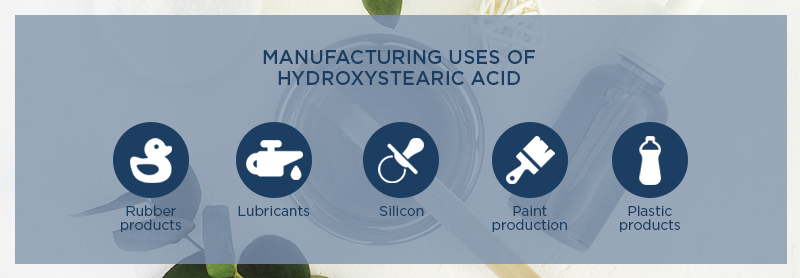
The benefits of hydroxystearic acid extend beyond the cosmetics industry — the surfactant, lubricating and thickening properties of 12-HSA are also beneficial in a wide range of manufacturing applications.
Below are a few of the common manufacturing applications of hydroxystearic acid:
- Rubber products: Hydroxystearic acid works as an activator, accelerator and internal lubricant for both synthetic and natural rubber. This property makes 12-HSA an ideal choice for the rubber production industry.
- Lubricants: 12-HSA can be used in calcium and barium, free multifunctional lithium, glycerol and higher-quality lubricants designed for use in cars, airplanes and other types of machinery. The surfactant capability of hydroxystearic acid helps prevent particles from sticking to engine parts, allowing the various components to move easily and keeping the motor in good condition.
- Silicon and lithium grease: Hydroxystearic acid is often used as a thickening agent in silicon and lithium-based grease.
- Paint production: When introduced to paint, hydroxystearic acid reacts with acrylic esters, producing stable thermosetting polymers. These polymers are often used to create high-quality industrial and automotive equipment, along with producing decorative metal coatings.
- Manufacturing of plastic products: Hydroxystearic acid is often used as an additive in the manufacturing of PVC products, including plastic siding, sheets, films, wall panels and window profiles.
- Other products: 12-HSA is also used in inks, hot melt adhesives and polishing products. Hydroxystearic acid can be found in drilling fluid additives, food packaging and as an intermediate for pharmaceuticals.
Resistant to oil, solvents and water, hydroxystearic acid can maintain its integrity in a variety of environments. 12-HSA can also withstand a wide range of temperatures, making it an appealing choice for many manufacturing processes.
Benefits of Hydroxystearic Acid in Cosmetics
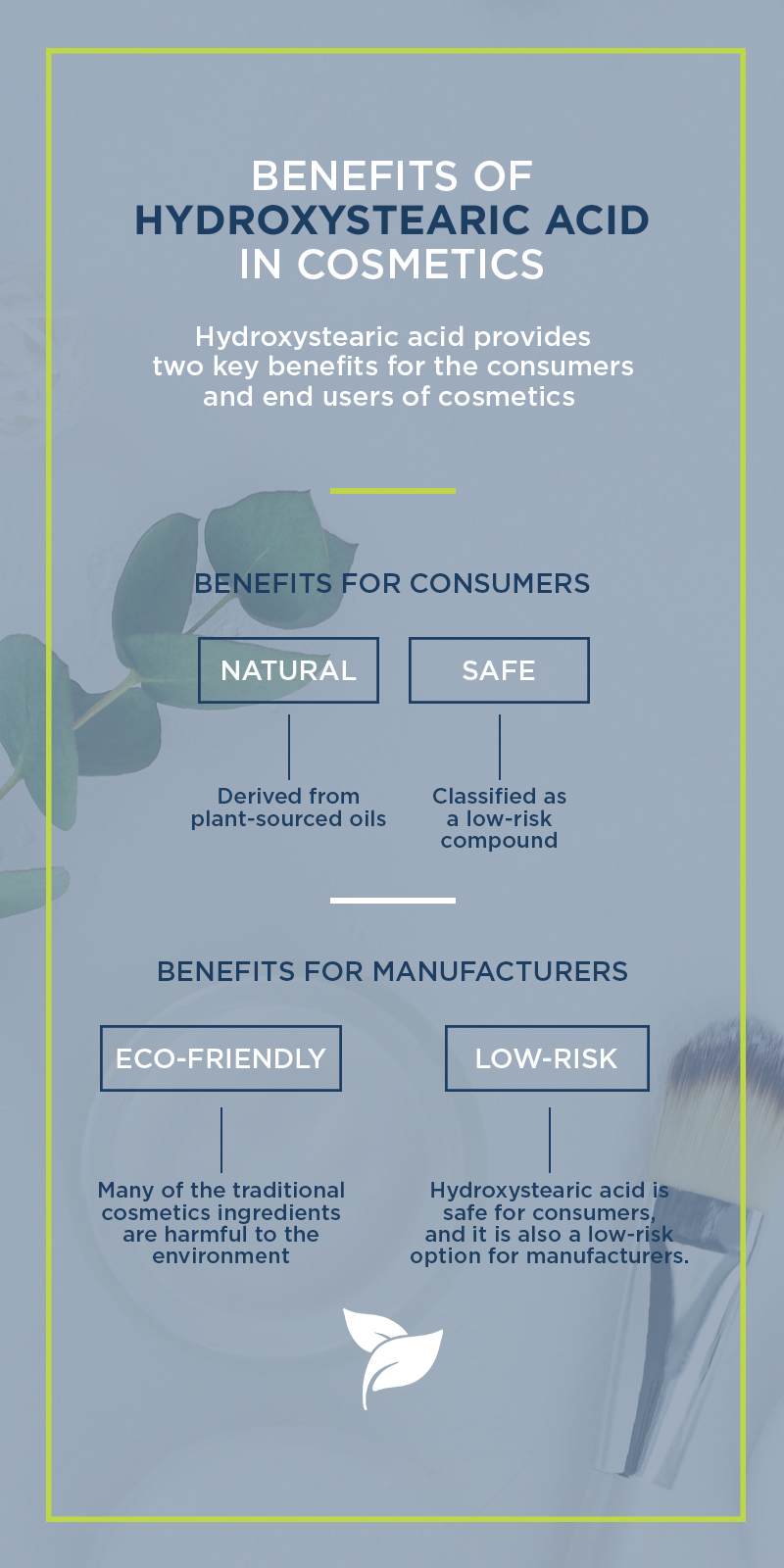
Because of its wide range of uses and applications, hydroxystearic acid is a practical and efficient choice for cosmetics and personal care products. Because 12-HSA is a natural and low-risk product, the benefits of hydroxystearic acid extend to both the consumers and manufacturers of cosmetics.
1. Benefits for Consumers
Hydroxystearic acid provides two key benefits for the consumers and end users of cosmetics — 12-HSA is a natural and relatively safe product, in stark contrast to its petrochemical competition.
- Natural: Derived from plant-sourced oils, 12-HSA is entirely vegetable-based, and it isn’t tested on animals during any stage of manufacturing. Hydroxystearic acid is a vegan compound, which appeals to consumers who are looking for natural, environmentally-friendly products.
- Safe: Hydroxystearic acid is classified as a low-risk compound, meaning that it doesn’t carry the same risk associated with other leading petrochemicals. Hydroxystearic acid won’t cause skin irritation or respiratory distress unless inhaled in excessive amounts, and during manufacturing, 12-HSA doesn’t come into contact with common allergens such as eggs, fish, gluten, grains, wheat or dairy.
Hydroxystearic acid is a natural and low-risk cosmetics ingredient, and besides creating high-quality products, it provides many benefits for consumers.
2. Benefits for Manufacturers
The same benefits that make hydroxystearic acid a perfect choice for consumers also make it advantageous for manufacturers.
- Eco-friendly: Many of the traditional cosmetics ingredients are harmful to the environment or human health. For manufacturers searching for eco-friendly alternatives, hydroxystearic acid is an ideal option. A vegetable-based oleochemical, hydroxystearic acid is a natural and sustainable resource. Unlike petrochemicals, 12-HSA is derived from a renewable resource, making hydroxystearic acid an eco-friendly choice for the cosmetics industry.
- Low-risk: Hydroxystearic acid is safe for consumers, and it is also a low-risk option for manufacturers. Nonflammable, non-reactive and not an explosive hazard, hydroxystearic acid is a relatively safe compound for cosmetics companies. However, as true when handling any chemical compound, make sure you take all standard safety precautions when handling hydroxystearic acid, such as wearing protective clothing, working in a well-ventilated space and administering first aid if it is ingested.
Hydroxystearic acid is a versatile compound that offers benefits for both consumers and manufacturers — eco-friendly, safe and stable, 12-HSA is a responsible choice for cosmetics products.
Future of the Hydroxystearic Acid and Cosmetics Markets
Hydroxystearic acid is a flexible oleochemical that is effective in a variety of industries. As the cosmetics industry grows, the importance and use of hydroxystearic acid will grow with it.
The success of hydroxystearic acid is spearheaded by a powerful movement within the personal care industry — as consumers push for green cosmetics, the demand for hydroxystearic acid will only increase.
The Green Cosmetics Movement
The production of oleochemicals has skyrocketed in the past years, and its success is closely tied to another cultural movement — the push towards green and sustainable cosmetics.
Across the industry, an increasing number of consumers pay attention to the ingredients of their favorite products. The average cosmetics consumer is more informed than ever before, and they are looking for products that will not harm their health or their environment.
To be labeled “green,” a product must include environmentally-friendly manufacturing practices, formulations or packaging. In the cosmetics industry, the definition goes a step further — to be considered “green,” a cosmetic product must contain natural ingredients derived from raw, renewable sources.
Choosing green cosmetics has several attractions for consumers and manufacturers. Along with promoting the long-term health of humans and the environment, “going green” encourages ecological responsibility and the production of higher-quality products. However, switching to sustainable ingredients is also a smart financial decision.
The green cosmetics industry has seen a 15 percent annual growth rate, and the trend isn’t expected to end any time soon. Some researchers estimate that by 2025, the organic beauty market will be worth $25.11 billion in the global economy.
Because hydroxystearic acid is a vegetable-derived, vegan ingredient, it appeals to consumers and manufacturers interested in the green cosmetics movement. Investing in this versatile oleochemical is a safe choice — as more and more consumers search for oleochemical-based products, having hydroxystearic acid on your ingredient list will expand your brand into the booming green cosmetics market.
Work With a Trusted Oleochemical Producer
Hydroxystearic acid is a valuable and versatile oleochemical, and it provides benefits for both consumers and producers. As more and more cosmetics brands turn to oleochemical solutions, don’t let your company be left behind.
When you begin to search for the highest-quality oleochemicals, you need a producer and supplier you can trust. For over 70 years, Acme-Hardesty has been a leading supplier of industrial chemicals. We are dedicated to providing safe and responsible chemical solutions from renewable, sustainable sources.
We are committed to global sustainability, and to help promote international attention and action, we are a part of multiple organizations and roundtables dedicated to raising the standard for environmental stewardship in the chemical industry. Acme-Hardesty is one of the nation’s largest and oldest importers and distributors of castor oil and its derivatives, and our wide range of products includes hydroxystearic acid.
Acme-Hardesty 12-HSA has an acid value between 175 and 185, a saponification value of 184 to 192 and a melting point of 72 degrees C. All testing on our hydroxystearic acid is conducted in controlled environments to the American Oil Chemists’ Society (AOCS) standards. Acme-Hardesty hydroxystearic acid is sold in flake form, and it is packaged in 50-pound bags and supersacks. You can store our hydroxystearic acid at ambient temperatures for up to two years without worrying about degradation, and you can easily purchase our hydroxystearic acid through our online store or by contacting our office.
At Acme-Hardesty, we can easily accommodate nearly any order size, whether you need a box, pallet or truckload. If you need a large quantity of hydroxystearic acid, contact our team to get a free quote on your order.
Work with an experienced, reliable and trusted source. Contact Acme-Hardesty for a free quote on hydroxystearic acid or other oleochemicals and esters today.

